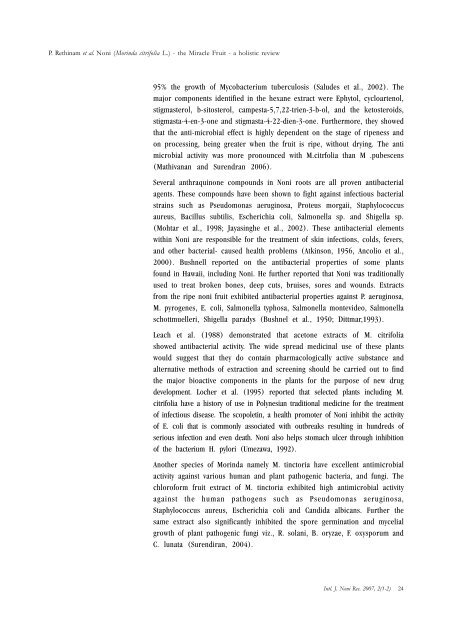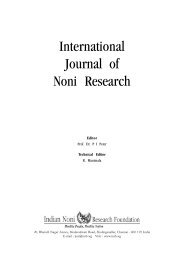International Journal of Noni Research - Noni Family
International Journal of Noni Research - Noni Family
International Journal of Noni Research - Noni Family
You also want an ePaper? Increase the reach of your titles
YUMPU automatically turns print PDFs into web optimized ePapers that Google loves.
P. Rethinam et al. <strong>Noni</strong> (Morinda citrifolia L.) - the Miracle Fruit - a holistic review<br />
95% the growth <strong>of</strong> Mycobacterium tuberculosis (Saludes et al., 2002). The<br />
major components identified in the hexane extract were Ephytol, cycloartenol,<br />
stigmasterol, b-sitosterol, campesta-5,7,22-trien-3-b-ol, and the ketosteroids,<br />
stigmasta-4-en-3-one and stigmasta-4-22-dien-3-one. Furthermore, they showed<br />
that the anti-microbial effect is highly dependent on the stage <strong>of</strong> ripeness and<br />
on processing, being greater when the fruit is ripe, without drying. The anti<br />
microbial activity was more pronounced with M.citrfolia than M .pubescens<br />
(Mathivanan and Surendran 2006).<br />
Several anthraquinone compounds in <strong>Noni</strong> roots are all proven antibacterial<br />
agents. These compounds have been shown to fight against infectious bacterial<br />
strains such as Pseudomonas aeruginosa, Proteus morgaii, Staphylococcus<br />
aureus, Bacillus subtilis, Escherichia coli, Salmonella sp. and Shigella sp.<br />
(Mohtar et al., 1998; Jayasinghe et al., 2002). These antibacterial elements<br />
within <strong>Noni</strong> are responsible for the treatment <strong>of</strong> skin infections, colds, fevers,<br />
and other bacterial- caused health problems (Atkinson, 1956, Ancolio et al.,<br />
2000). Bushnell reported on the antibacterial properties <strong>of</strong> some plants<br />
found in Hawaii, including <strong>Noni</strong>. He further reported that <strong>Noni</strong> was traditionally<br />
used to treat broken bones, deep cuts, bruises, sores and wounds. Extracts<br />
from the ripe noni fruit exhibited antibacterial properties against P. aeruginosa,<br />
M. pyrogenes, E. coli, Salmonella typhosa, Salmonella montevideo, Salmonella<br />
schottmuelleri, Shigella paradys (Bushnel et al., 1950; Dittmar,1993).<br />
Leach et al. (1988) demonstrated that acetone extracts <strong>of</strong> M. citrifolia<br />
showed antibacterial activity. The wide spread medicinal use <strong>of</strong> these plants<br />
would suggest that they do contain pharmacologically active substance and<br />
alternative methods <strong>of</strong> extraction and screening should be carried out to find<br />
the major bioactive components in the plants for the purpose <strong>of</strong> new drug<br />
development. Locher et al. (1995) reported that selected plants including M.<br />
citrifolia have a history <strong>of</strong> use in Polynesian traditional medicine for the treatment<br />
<strong>of</strong> infectious disease. The scopoletin, a health promoter <strong>of</strong> <strong>Noni</strong> inhibit the activity<br />
<strong>of</strong> E. coli that is commonly associated with outbreaks resulting in hundreds <strong>of</strong><br />
serious infection and even death. <strong>Noni</strong> also helps stomach ulcer through inhibition<br />
<strong>of</strong> the bacterium H. pylori (Umezawa, 1992).<br />
Another species <strong>of</strong> Morinda namely M. tinctoria have excellent antimicrobial<br />
activity against various human and plant pathogenic bacteria, and fungi. The<br />
chlor<strong>of</strong>orm fruit extract <strong>of</strong> M. tinctoria exhibited high antimicrobial activity<br />
against the human pathogens such as Pseudomonas aeruginosa,<br />
Staphylococcus aureus, Escherichia coli and Candida albicans. Further the<br />
same extract also significantly inhibited the spore germination and mycelial<br />
growth <strong>of</strong> plant pathogenic fungi viz., R. solani, B. oryzae, F. oxysporum and<br />
C. lunata (Surendiran, 2004).<br />
Intl. J. <strong>Noni</strong> Res. 2007, 2(1-2) 24








